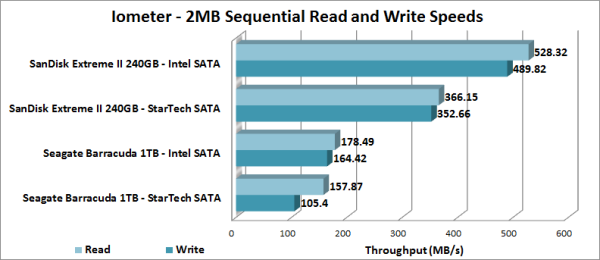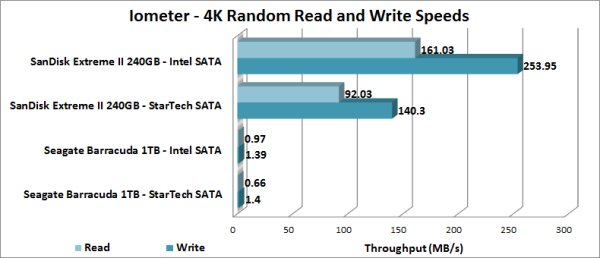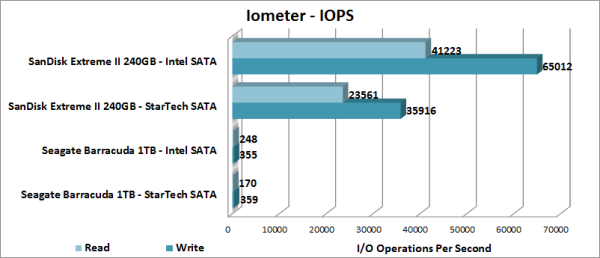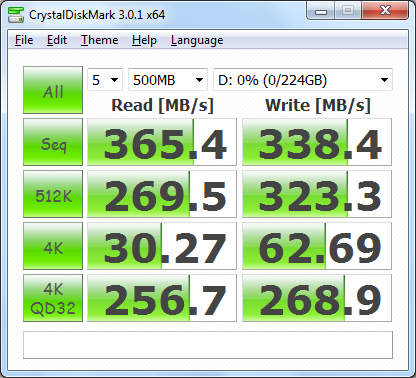The test system used in this review was an HP 8200 Elite. The computer came equipped with an Intel Core i5-2400 CPU, 4GB of DDR3 1333MHz memory, Seagate Barracuda 7200.12 ST3250312AS 250GB SATA 6 Gb/s hard drive, NVIDIA Quadro FX580 512MB PCIe graphics card and an Intel 82579-LM gigabit network card. For the operating system, I installed a fresh copy of Windows 7 Enterprise.
With the PEXSAT34SFF requiring an additional Mini SAS breakout cable, we will only be testing the PEXSAT34RH. To test the card, I ran a series of benchmarks with CrystalDiskMark 3.0, ATTO Disk Benchmark 2.46 and Iometer using SanDisk's Extreme II SSD and a pair of Seagate Barracuda 1TB (ST1000DM003) hard drives. The drives were tested individually, with the two hard drives in RAID and then with HyperDuo enabled.
CrystalDiskMark 3.0:
First, I ran a few quick tests using CrystalDiskMark. This benchmark tool measures the performance of a storage device by testing its sequential read and write speeds as well as its random read and write speeds using blocks 4KB and 512KB in size.
 Seagate Barracuda Hard Drive - StarTech SATA |
 Seagate Barracuda Hard Drive - Intel SATA |
|
Looking at the screenshots above you can see that StarTech's RAID controller did not perform as well as the onboard Intel SATA controller. The difference was only 16-18 MB/s when testing with the hard drive but this grew to more than 144 MB/s with SanDisk's Extreme II SSD.
ATTO Disk Benchmark 2.46:
I also used ATTO Disk Benchmark to test the PEXSAT34RH's sequential read and write speeds. The tests are run using blocks ranging in size from 0.5KB to 8192KB and the total length set to 32MB and 256MB.
 Seagate Barracuda Hard Drive - StarTech SATA |
 Seagate Barracuda Hard Drive - Intel SATA |
|
The performance with ATTO was very similar to what we saw with CrystalDiskMark. Compared to the onboard Intel SATA controller, StarTech's RAID controller was a good 15 MB/s slower when tested with the hard drive and about 150 MB/s slower with the SSD.
Iometer:
Lastly, I ran a series of tests using Iometer. This tool can be configured to benchmark a number of things. In this case, I used it to measure the PEXSAT34RH's read and write speeds and the number of operations per second. The tests were run using random bytes and a queue depth of 3.

At this point, the results really shouldn't be too surprising. Even with Iometer, StarTech's RAID controller was slower than the onboard Intel SATA controller when doing sequential reads and writes.


StarTech's RAID controller also lagged well behind when doing random reads and writes with SanDisk's Extreme II SSD. In our tests, we saw a performance difference of more than 113 MB/s and nearly 30,000 IOPS.





